After now 20 sprints to set for our team, an optimal sequence of the Organization of sprints. The tools we use Excel, TFS, Scrum for Team System (Conchango) and the Task Board for Team System . I want you three Blog parts imagine how we use the tools for SCRUM and how the end of the sprints designed it.
Part 1: Sprint planning
Part 2: Daily scrums
Part 3: Sprint Review & Retrospective
Part 1: Sprint planning

We have been building our 4th Sprint all artifacts of the sprints in to TFS. Using TFS to Begin was time-consuming than the use of index cards on tried and true whiteboards. But it has quickly established a routine and is promptly rewarded by automatically generated burndown charts, user stories, backlogs, test plans or version plans. All this information is preparing TFS on a timely and convenient. And for this effort and time spent really worth!
The sprint planning is at the beginning of each sprint. The following procedure (and time) has established itself:
- capacity planning of the team for the sprint period
(15 minutes)
- development of TFS work items of type "Sprint"
(1 minute)
- setting all the Sprint Backlog Items (SPI) for the upcoming product backlog items (PBI)
(1 afternoon)
- Commitments of the team to the Sprint Goal
(10 minutes)
- transferring the results into TFS
(30 minutes)
Before starting the sprint planning, the capacity of the team in the sprint period requested. I have this created an Excel template. In this enters each team member, how many days it is a week in the upcoming sprint duration.
| | Fritz | Günther | Anna | Gerd | |
| 1.Woche | 3 | 5 | 5 | 5 | |
| 2.Woche | 5 | 0 | 5 | 5 | |
| 3.Woche | 5 | 0 | 5 | 4 | |
| Total (days) | 13 | 5 | 15 | 14 | |
| sum (h) | 104 | 80 | 120 | 112 | |
| correction factor | 0.9 | 0.9 | 0.8 | 0.7 | |
| hours (approx.) | 93 | 72 | 96 | 78 | 330 |
For team members, have the unpopular side jobs, which can hardly be part of the planning, we have introduced a correction factor empirically. This time we improve our estimate. Anna is our build Masterin (for other teams) and can develop only 80%, Gerd supports the support and therefore has a factor of 0.7 (70%). This is not to calculate the precise number of hours with "decimal point". Important, only the magnitude.
b) Development of a TFS work items of type "Sprint"
Now a new TFS work item is created, type "Sprint".
This is done via the menu entry Add Work Item .
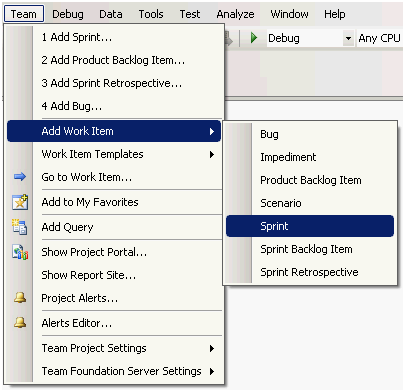
The determined from the capacity planning hours are entered in the field Capacity (hours) . In field
Sprint name the iteration is selected (iterations are created in the TFS Project Settings). The field
Sprint Goal bleit still empty and is filled until the end of the planning meetings with the summary of commitment to the Sprint goal.
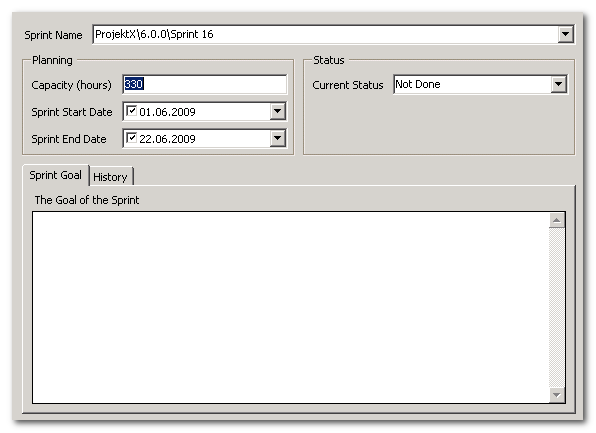
c) setting all the Sprint Backlog Items (SPI) for the upcoming product backlog items (PBI)
Now Finally we come to the core: the actual sprint planning!
this purpose, the team in a room. The upcoming PBI is known then it applies to each of the PBI, the SPIs to be determined. These controls each team member's input to the task at hand. We consider this an Excel table set, we project with a projector on the wall. This is often very dynamic. Points are being added, which it will be deleted, it is estimated, distributed, combined ... This dynamic is the reason why we keep all the points, first in Excel and create not just in TFS. work items can not be erased together, or split up. How does
the Excel template from?
In its list of PBI, we write all the necessary SPIs and appreciate their effort.
| legend | |
| Product Backlog Item (sorted by priority) | sum hours |
| Sprint Backlog Items (defined in this planning session) | hours estimated |
Use the sum function by Excel, the hours are calculated for the PBI. With capacity in mind is soon clear that PBI in the sprint can be implemented and what not.
The example below shows a planning table in Excel. The user story such as D can not be performed because the capacity already exhausted with C user story is.
| 1 User Story A | 120 |
| New data field "expired" in DB | 4 |
| Property and validation in MT | 8 |
| unit test | 4 |
| GUI extension | 4 |
| etc ... | |
| 2 User Story B | 88 |
| SPI 1 | 8 |
| SPI 2 | 2 |
| etc ... | |
| 3 User Story C | 120 |
| SPI 1 | 6 |
| SPI 2 | 6 |
| etc ... | |
| 4 User Story D | 48 |
| SPI 1 | 6 |
| SPI 2 | 6 |
| etc ... | |
Here is a screenshot of the sprint planning with Excel:
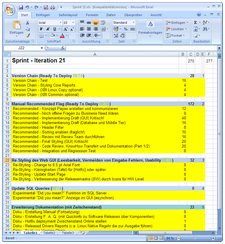
d Commitment) of the team to the Sprint Goal
At the conclusion of the sprint planning session, the team needs a commitment to Sprint Target release.
The Sprint Goal is a brief summary of what is being done in the proposed Sprint.
e) transferring the results into TFS
for the team members is to plan now complete. Then I prepare everything in TFS for the next sprint. This requires all Product Backlog Items (PBI) updated be and the new Sprint Backlog Items (SPI) is applied. First of all I
as a stale PBI the next sprint.
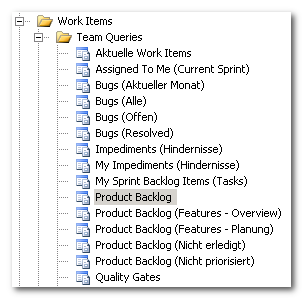
About the Work Item list, I sort Product Backlog Items to Business Priority .
Here, I assign the number to fast all affected PBI field Release and / or Sprint the sprint.
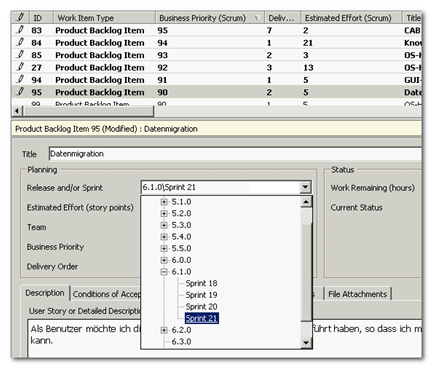
are updated every PBI I start the associated SPI. This can also be done via the Team Explorer. I'm using but the Task Board for Team System . This tool makes the work much more quickly and after 2-3 sprints you have paid for the license costs about 50 € loose.
You start the task board , selects the desired sprint and it is an appealing WPF interface that is reminiscent of a task board on a whiteboard.
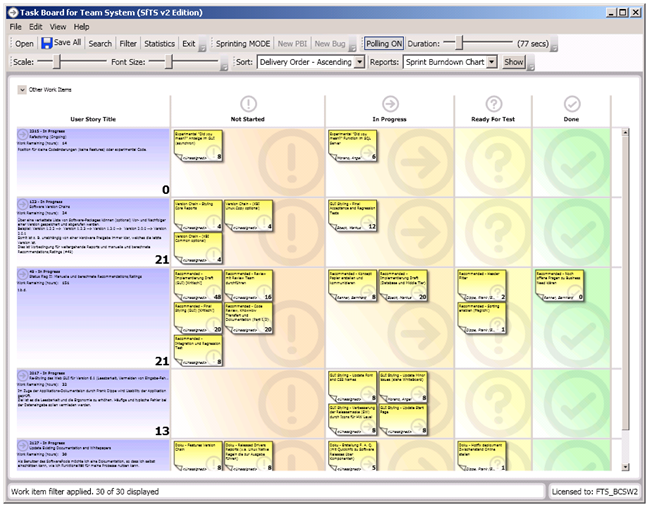
All SPIs to a PBI, you can now create quickly
calls by using the context menu, the menu item Add Sprint Backlog Item .
In Title and Description you I shall indicate the most important items for the SPI. The field
Description is in fact often empty.
it is important to enter the hours under SPI Estimanted Effort and Work Remains . The field
Assigned To remains empty at the beginning. It was not until the Daily scrums share the tasks to team members themselves. can
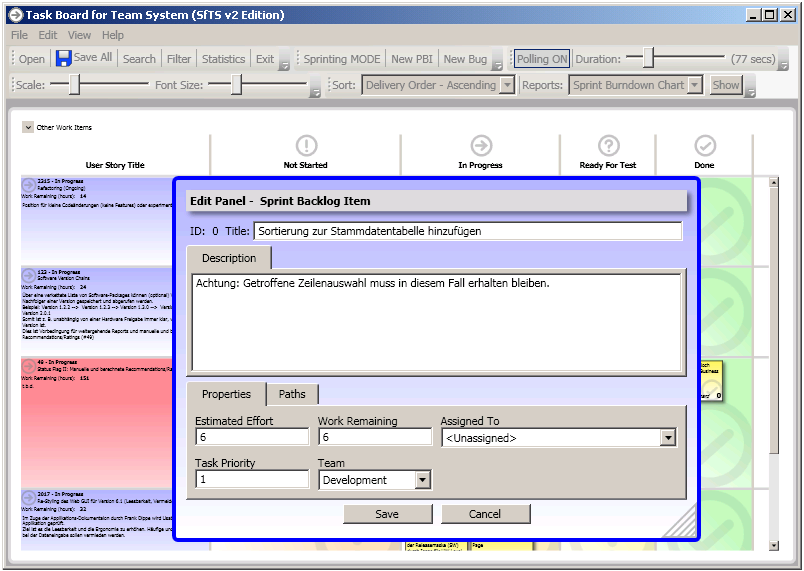
are updated every PBI and built all the SPIs the sprint start ...
0 comments:
Post a Comment